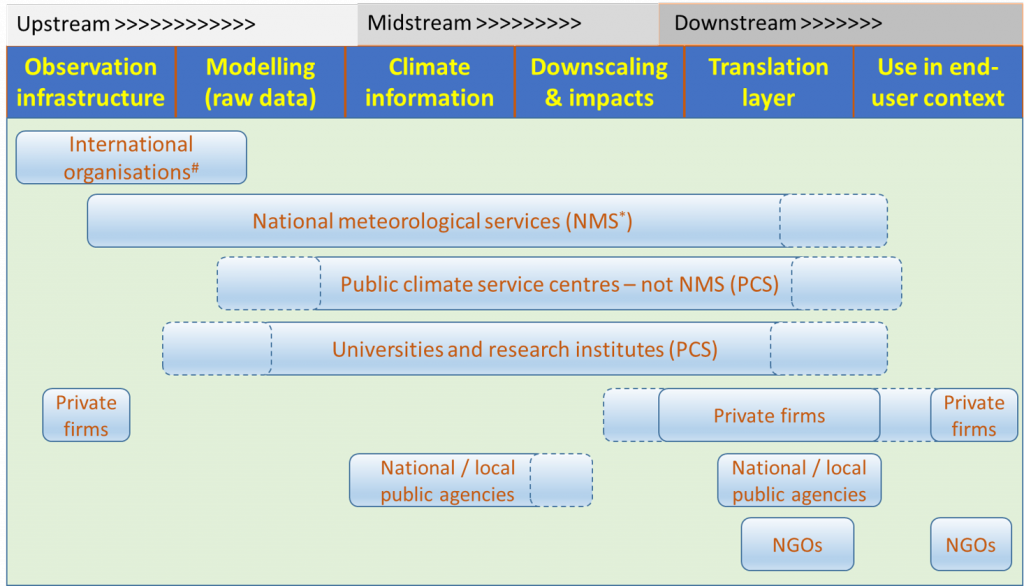A climate service is useful if a user can identify benefits that can be appropriated, and which are expected to be larger than the costs of acquisition and use of the climate service, while users’ benefits should not go at the expense of third parties.
ADRIAAN PERRELS, ATTE HARJANNE, JUHA A. KARHU, VÄINÖ NURMI, KAROLIINA PILLI-SIHVOLA, TUUKKA RAUTIO, REIJA RUUHELA, HEIKKI TUOMENVIRTA
Finnish Meteorological Institute
We understand ‘climate services’ (hereafter CS) as the transformation of climate related data, often together with other information, into customized information products, offered as such or visualized or embedded in consultancy and/or education (condensed version of EC Roadmap definition – EC 2015). This means that CS can entail quite different things, such as seasonal vs. adaptation oriented CS or qualitative guidelines vs. visualized model output.
Despite wide spread referencing to the Roadmap definition, actual development and provision of CS is very often still mainly driven by science & technology push rather than demand pull (Lourenço et al., 2016).
In the FMI led EU-MACS study factors that impede the uptake of CS in various sectors were assessed (Hoa et al., 2018). Among others CS are hitherto predominantly developed by public expert organisations, which by their very nature are less inclined to ponder their position in the CS value chain (Fig. 1), while their strengths and resources tend to emphasize the upstream part.

Public CS developers and providers should ponder their position in the value chain as well as those of other providers. The more downstream in the value chain the higher the (potential) value added of a CS gets, but also the more diverse the required expertise and input information tends to be. In turn this means that CS provision increasingly needs to be supported by proper business models, in order to have viable and societal beneficial CS. During the market and business model analysis the end-users’ benefit generation process and its functionality preconditions should get clear. By then one should know what constitutes a useful CS – at least for that user. This clarification process should also enable the provider – in cooperation with the user – to provide an estimate of the amount of value the CS can create for the user.
Another point of attention is standardization of terms and product categories, which supports quality control and comparison. Where relevant, quality assurance should extend to non-climate data when moving along the value chain, and be clearly communicated.
Acknowledgements: EU-MACS received funding from the European Union’s Horizon 2020 Research and Innovation Programme under grant agreement No. 730500.
References
Cortekar, J. et al., 2017: Review and analysis climate service market conditions, EU-MACS Deliverable 1.1.
Hoa, E. et al., 2018: From generating to using climate services – How the EU-MACS and MARCO projects help to unlock the market potential, Climate Services, 11, 86–88.
Lourenço, T.C., et al., 2016: The rise of demand-driven climate services, Nature Climate Change, 6, 13–14.
Perrels, A. et al (2018): A Structured Analysis of Obstacles to Uptake of Climate Services and Identification of Policies and Measures to Overcome Obstacles so as to Promote Uptake, EU-MACS Deliverable 5.1, 02.12.2018.
HOW TO CITE THIS ARTICLE:
Perrels A., Harjanne A., Karhu J. A., Nurmi V., Pilli-Sihvola K., Rautio T., Ruuhela R., Tuomenvirta. H., 2019: What makes a climate service useful?, FMI’s Climate Bulletin: Research Letters, 1(1), 10, DOI: 10.35614/ISSN-2341-6408-IK-2019-08-RL
CITATION INFORMATION:
Authors: Adriaan Perrels, Atte Harjanne, Juha A. Karhu, Väinö Nurmi, Karoliina Pilli-Sihvola, Tuukka Rautio, Reija Ruuhela, and Heikki Tuomenvirta
Received: March 28, 2019
Accepted: June 11, 2019
First online: June 19, 2019
Published: June 20, 2019
Journal: FMI’s Climate Bulletin: Research Letters
Volume: 1
Issue: 1
Page: 10
DOI: 10.35614/ISSN-2341-6408-IK-2019-08-RL
Header image: Eija Vallinheimo




